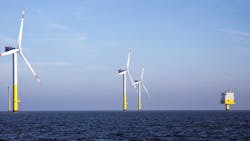TenneT awards contracts for three more offshore grid connection systems
Offshore staff
HOUSTON – TenneT has awarded contracts for three more offshore grid connection systems in the German North Sea.
As with the contracts for 11 grid connection systems in the German and Dutch sectors issued late last month, all deliveries are due to be completed by 2031.
The 2-GW technology components for converting alternating current into direct current (DC) and back will be manufactured exclusively at European production sites of the consortia involved in the project.
Siemens Energy/Dragados secured contracts for BalWin3 and LanWin4 (both with a connection to the onshore grid in Wilhelmshaven) and LanWin2 (with a connection near Heide).
GE/McDermott will fabricate components for BalWin4 and LanWin1, both to be connected in Unterweser.
Hitachi Energy/Petrofac have the contracts for five Dutch projects to be connected in Borssele (IJmuiden Ver Alpha, Nederwiek 1), Eemshaven (Doordewind 1 and Doordewind 2) and Geertruidenberg or Moerdijk (Nederwiek 3). This cooperation will also manage the German connection LanWin5 (close to Rastede).
GE/Sembcorp Marine have responsibility for three Dutch projects to be connected in the Maasvlakte, Rotterdam (IJmuiden Ver Beta, IJmuiden Ver Gamma and Nederwiek).
All agreements apply to both the offshore and onshore converter stations and the associated HVDC technology, which enables bidirectional conversion of DC and alternating current (AC). Total volume of the orders for the components of the 14 systems is about €30 billion ($33 billion).
A consortium of Siemens Energy and Dragados Offshore has signed a framework agreement with German-Dutch transmission system operator TenneT to supply HVDC transmission technology for three grid connections in the German North Sea. The projects available through the agreement will ensure that a total of 6 GW of offshore wind power can be transported onshore. The contract value for the consortium of Siemens Energy and Dragados Offshore is close to €7 billion ($7.7 billion).
The three grid connections, named BalWin3, LanWin2 and LanWin4, will transport electricity from wind farms in the German North Sea to grid connection points in the north of Germany. Each of the systems has a transmission capacity of 2 GW. Siemens Energy will manufacture the main electrical components, such as switchgears, transformers and converter technologies, at its factories in Europe. The Spanish consortium partner Dragados Offshore is responsible for the construction and offshore installation of the platforms.
Siemens Energy had already won major orders for the connection of wind farms in the German North Sea as recently as the end of 2022. With the three new projects, the company is currently handling 11 HVDC grid connection projects worldwide to connect wind farms in Germany, the UK and the US, and can look back on five completed projects in the German North Sea. Once the 11 ongoing projects are commissioned, Siemens Energy's HVDC technology will feed more than 19 GW of wind power into high-voltage grids worldwide.
Wind turbines generate electrical energy as AC. To transport the electricity from offshore wind farms onshore, it has to be converted into DC. Siemens Energy's HVDC transmission technology, which has been installed in offshore converter platforms, takes care of this. The platforms, steel structures as tall as houses that stand on stilts in the sea near the wind farms, collect the electricity from the wind turbines. Inside them, the AC is converted into DC. Only in this way can more electricity be transported to land with reduced losses through cable systems, some of which are several hundred kilometers long. There, the onshore converter station receives the DC and converts it back into AC so it can be fed into the German high-voltage grid and ultimately brought to consumers.
04.24.2023
